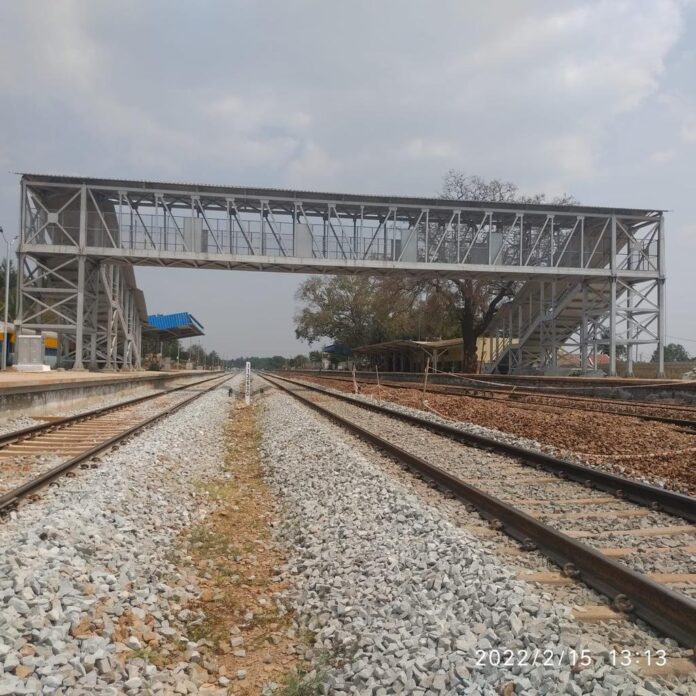Steel foot over bridges have emerged as a transformative solution for their ease of construction. These structures are reshaping the landscape of Southwestern Railway, Karnataka, setting new benchmarks in construction speed and urban adaptability.
One of the important structures in civil engineering is a bridge. Steel foot over bridges are widely adapted by railways, providing overall ease and economy for construction. It is easy to construct within a short time and is environment and commuter-friendly.
Project brief
The footbridges Southwestern Railway, Karnataka are examples of the benchmark established by Tata Structura. The project was undertaken by Rail Vikas Nigam (RVNL) under railway redevelopment schemes for the construction of new foot-over bridges and cover-over platforms. Marvel Consultant was appointed as the structural consultant for designing FOBs and COPs using hollow sections. Krishi Infra, PJB and a few others were the contractors on the job.
Choice of material
The FOB uses lighter structural members making it easy to be erected on site with simple weld and bolt connections. Another major advantage is that they can be cut or moulded into any shape or size desired without wasting material and constructed rapidly. Steel structures can be pre-fabricated in the workshop or off-site therefore requiring less area at the construction site and this is highly advantageous in congested urban areas.
A truss framework for the FOBs is the most optimal solution. The sides can be efficiently utilised for the depth requirement of the structure. This not only gives a good clear height from the ground level but also reduces the height of the FOB structure to improve convenience for commuters.
Traditionally, built-up sections using open steel sections like channel sections are used for heavy structural members like primary column members. However, for the projects executed by South Western Railways after 2016, tubular columns were used which saved a lot of fabrication time, effort and costs. The flexibility and reduced construction time offered by tubular structural steel have made it the preferred material for these types of FOBs even for road traffic. High tensile strength Tata Structura Steel Hollow section structural members were used in the structural systems. The hollow geometry of Tata Structura offered the highest radius of gyration keeping the slenderness limits in range for the required compressive loads. The sections also offered neat and clean connections for a good visual appeal.
Approximately 2000 MT of steel has been used by South Western Railways in the construction of more than 40 FOBs and COPs in different railway stations of Karnataka.
Architectural details
A mirrored N-type configuration for the trusses was adopted in the truss arrangement of the walkway which provides a very pleasant look. The spans of the bridges vary from 19.3 m to 31.5 m for 2 tracks, 3 tracks and 4 tracks with a walkway width of 2.5 m, 3.2 m and 6 m in some cases. Notably, in all these designs, only Tata Structura hollow sections have been used in primary and secondary members. They required around 15 to 26 MT of hollow sections for different spans with staircase arrangements and 12 MT for ramps which were placed on opposite sides of staircases. The Codal life of these FOBs is as per Research Designs & Standard Organisation (RDSO).
Challenges
The primary challenge revolved around the structural design of these foot-over bridge structures, marking the debut of tube usage while adhering to the stringent RDSO standards. The choice of hollow sections was driven by the objectives of cost-effectiveness and robust design, necessitating the use of lightweight components with appropriate stiffness, refined through thorough iterations. Ensuring seamless and straightforward connections was equally crucial. Given the application of hollow sections in railway projects, the initial designs underwent scrutiny by the Indian Institute of Technology, Madras, to instil confidence among railway authorities and contractors.
In Conclusion
The modern engineering and design of these foot-over bridges represent the marked development perceived in the railway infrastructural sector in India. The usage of hollow structural steel sections has helped in savings of over 15 per cent with respect to the FOBs constructed using conventional open sections. By providing neat connections, the new bridges made using hollow sections have a modern aesthetic appeal. Once again, Tata Structura established hollow sections as the preferred material for building the prospect of tomorrow’s India.


Quote:
“Public spaces that we design today are going to last for some time, inspiring a whole new generation. Hence, it is important that designs have a great outlook. It should have good sensibility and an optimised design that is clearly visible to any commuter. The new FOBs installed by South Western Railways designed using Tata Structura hollow steel sections offer the same perspective. We wish the transformation reaches other sectors in our country”
– Ravi Kumar, Senior Area Manager, Tubes SBU, Tata Steel
Fact File
Client: Southwestern Railways
Project Management Consultant: RVNL
General Contractor: Krishi Infra, PJB & others
Fabricator: Krishi Infra, PJB & others
Steel Supplier: Tata Structura





